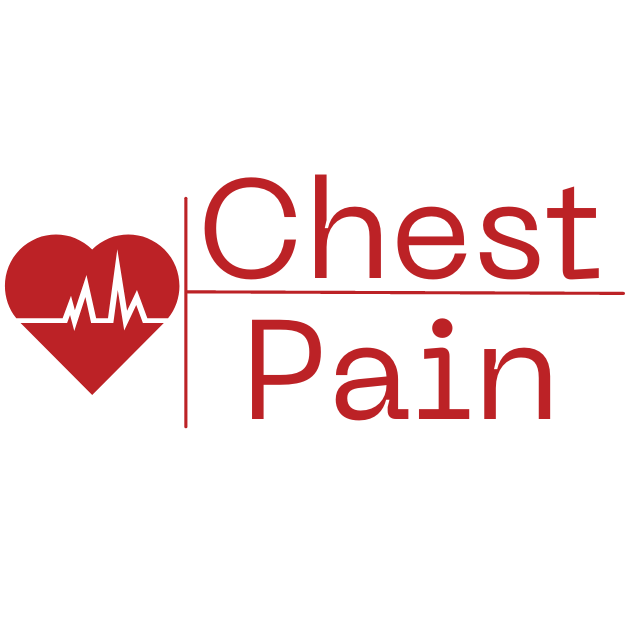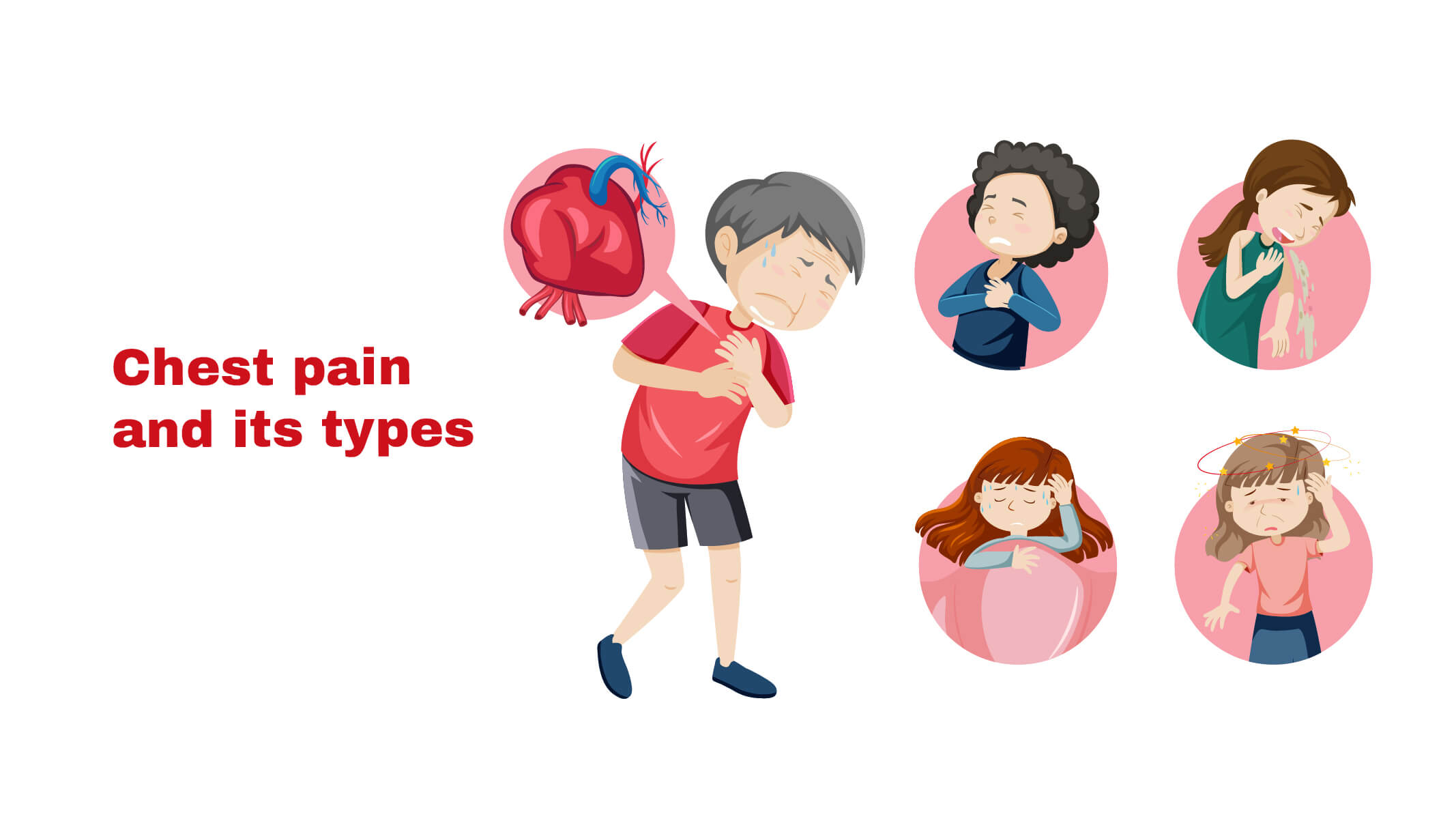Chest pain can appear in various types, ranging from a piercing stab to burning pain. It can sometimes feel like a burning sensation or crushing. Sometimes, the aching moves up the neck, into the jaw, and then enters the back of the body or runs downward one or both arms. The most life-threatening reasons for chest pain are connected to the heart or lungs. As chest discomfort can express a severe condition, it is essential to take medical help immediately.
Types of chest pain:
The underlying cause of the pain may be piercing, dull, burning, stabbing, tight, or distressing. You must describe your pain to your physician to assist the medical professional in determining the cause of your pain. Let us look at some of the different kinds of chest discomfort and the body organ involved in it.
- Heart:
- Myocardial Infarction: When there is an obstruction in blood flow to the heart, a heart attack occurs. The development of fat, cholesterol, and different materials creates plaque in the arteries that supply the coronary arteries, causing blockage in the arteries and blood vessels. In some cases, a plaque can burst and cause a blood clump which interrupts blood flow. This interruption of the blood flow can harm or destroy parts of the heart muscle. Myocardial infarction is the consequence of a heart attack that can be life-threatening.
Symptoms: Signs of a heart attack:
- A heart attack usually includes aching in the center or left side of the chest that remains for more than several minutes or that comes and goes. The pain may manifest as stress, squeezing, fullness, or discomfort.
- A heart attack can also cause you to feel weak, lightheaded, or dizzy. Cold sweat may also accompany these symptoms.
- Jaw, neck, or backache
- Soreness in one or both arms or shoulders
- Breathing issues sometimes occur together with chest discomfort, but it may also appear before chest discomfort.
Other heart attack symptoms may include abnormal or inexplicable fatigue, nausea, or vomiting. These signs are more eminent in women.
Causes:
- The reason for a heart attack is the blockage of one or more of your coronary arteries. The development of fatty deposits, including cholesterol, can eventually form materials called plaques, which can shrink the arteries over time (atherosclerosis).
- The plaque rupture may cause cholesterol and other substances to enter the bloodstream during a heart attack. This causes a blood clot to form. Large clumps can obstruct blood circulation across the coronary artery, depriving the heart of oxygen and nutrients (ischemia).
- Other reasons for a heart attack are a coronary artery convulsion that restricts blood circulation to part of the heart.
- Smoking and the use of illicit substances, such as cocaine, can result in fatal spasms.
- Angina: It is a sign of heart disease that happens due to blocked arteries or insufficient blood circulation to the arteries, which carry oxygen-rich blood to the heart. The sensation may sense similar to myocardial infarction, with a sense of stress or squeezing in the chest. It may also be known as angina pectoris or ischemic chest pain. Angina normally disappears within a short period but it can be a symptom of a fatal heart condition.
Symptoms: Angina symptoms include;
- chest discomfort and pain
- Burning
- Stress
- Fullness
- Compression
- Dizziness
- Tiredness
- Indigestion
- Breathing difficulties
- Excessive sweating
In addition, the arms, neck, jaw, shoulder, and back may also be painful.
Causes: Angina occurs due to the accumulation of fatty substances in the arteries supplying blood to the heart muscles; the process is called atherosclerosis. Several factors can increase the risk of atherosclerosis, including:
- A poor diet
- Insufficient physical activity
- Tobacco use
- Aging
- Having a family history of atherosclerosis or cardiovascular disease
- Lungs:
- Pulmonary embolism (PE): In a pulmonary embolism, a blood clump lodges in the lung’s blood vessels or other body parts such as the leg or arm. It causes restriction of blood circulation to the lungs, a reduction of oxygen amount in the lungs, and an increase in BP within the pulmonary arteries. Patients who do not receive immediate treatment for PEs may suffer heart or lung failure and even die.
Symptoms: The symptoms of pulmonary embolism can differ widely reliant on how much of your lung is intricate, the size of the clumps, and whether you have hidden lung or cardiovascular illness. The following signs are familiar:
- Shortness of breath: It generally occurs suddenly and tends to worsen with strain.
- Chest pain: The discomfort is usually serious and is felt when you breathe deeply. You can also sense it when you sneeze, bend or lean down.
- Blood in the sputum during coughing
- An irregular or rapid heartbeat
- Feeling dizzy or lightheaded
- Suffering from excessive sweating
- High temperature
- Pain or swelling in the leg, usually in the calf
- Discoloration of the skin (cyanosis)
Causes: There are several causes of pulmonary embolism;
- An accumulation of blood in a specific area of the body (generally an arm or leg) that usually occurs after a prolonged period of inactivity, like after an operation or bed rest.
- An injury to veins especially in the pelvis, hip, knee, or leg.
- A stroke is often a complication of other medical situations like cardiovascular disease (such as congestive heart failure, atrial fibrillation, and heart attack) or a stroke.
- The increase, elevation, or in some cases, reduction of clumping factors in the blood. Particular kinds of cancer and women undergoing hormone replacement therapy or birth control pills may experience elevated clumping factors. As a consequence of genetic conditions, unusual or low clumping factors can also happen.
- Pulmonary hypertension: Pulmonary hypertension occurs when excess stress in the blood vessels leads from the heart to the lungs. The blood vessels that supply the lungs build an elevated amount of muscle in their walls due to pulmonary hypertension.
Symptoms: Hypertension of the lungs includes the following symptoms.
- Inflammation in the legs
- Fainting frequently
- Long-lasting fatigue
- Intense chest pain
Causes: There are several causes of pulmonary hypertension, such as;
- Congenital diseases of the lungs
- COPD
- unhealthy lifestyle habits such as smoking
- Gastrointestinal:
- Acid reflux: Gastroesophageal reflux disease, or acid reflux, happen when the stomach contents return to the esophagus and throat. Regrettably, acid reflux can irritate the esophagus and throat, which can be very distressful. You may experience a burning sensation in your chest or throat caused by acid reflux.
Symptoms: The symptoms of acid reflux include;
- Breathing issues
- Cough
- Tightness in throat
- Burning Chest pain
- Heartburn
- Bitter taste
Causes: Many factors can cause acid reflux and burning chest pain. Some of these factors include;
- Tobacco
- Overweight
- Pregnancy
- Consumption of spicy foods
- Medicines
- Chronic stress
- Peptic ulcers: Peptic ulcers are open sores within the stomach. It is common for stomach ulcers that cause severe chest and stomach pain.
Symptoms: You may experience the following symptoms of peptic ulcer;
- Pain radiating from your chest to your belly
- Feeling inflated despite not eating anything
- Burp excessively
- Reduced appetite and weight loss
- Dark or bloody stools
- Nausea or vomiting
Causes: The covering of the stomach, esophagus and small intestine is prone to breakdown for various reasons such as;
- Helicobacter pylori (H. pylori): A kind of bacteria that becomes the reason for stomach infections and swelling
- Frequent consumption of aspirin (Bayer), ibuprofen (Advil), and other anti-inflammatory medications
- Smoke
- Excessive alcohol consumption
- Undergoing radiotherapy
- Stomach cancer
References:
- https://www.mayoclinic.org/diseases-conditions/heart-attack/symptoms-causes/syc-20373106
- https://www.webmd.com/heart-disease/heart-disease-angina
- https://my.clevelandclinic.org/health/diseases/17400-pulmonary-embolism

